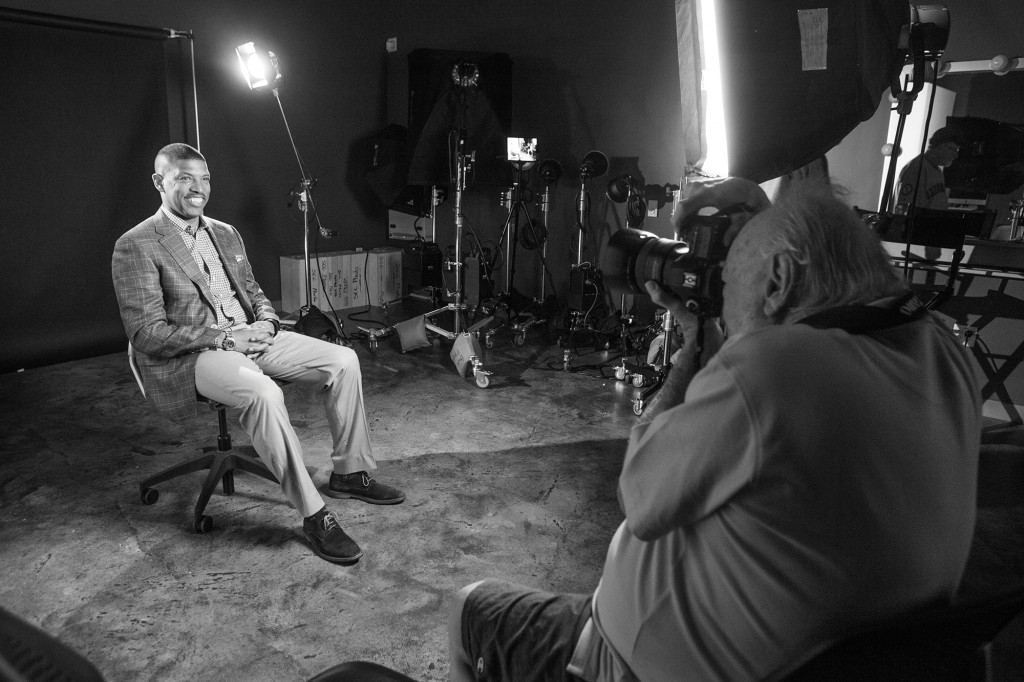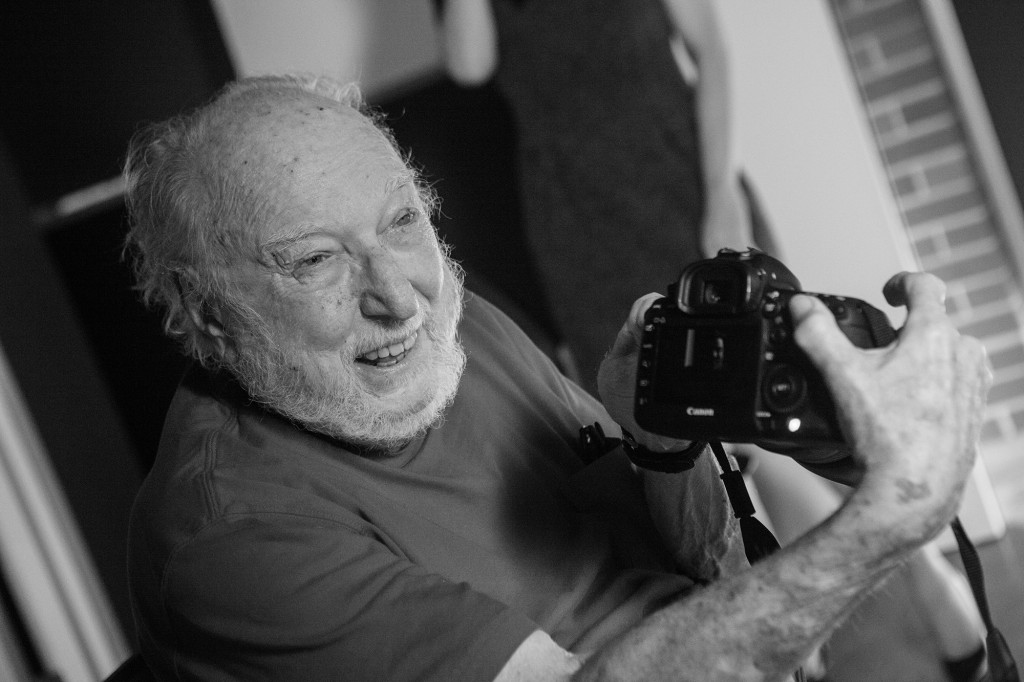
As he sits in his library at home, surrounded by thousands of books, CDs and pieces of art collected over the years, Russ Solomon is quiet. Bits of his past still show in his face, in his thick, once grey, now fully white, beard and his brushed-back hair. It’s quite the contrast compared to stories I’ve heard of the young, energetic man who turned a mom-and-pop record store into a pop culture icon. But he’s 90 years old — 65 years older than I am.
Solomon spent 46 years building what was once the largest record store company in the world. At its peak, Tower Records had close to 200 stores nationwide, including Japan, Ireland, England and even countries in South America. In 2006, the company filed for Chapter 11 bankruptcy a second time, losing all of its stores in the process.
“You don’t want to talk about this Tower shit, do you?” Solomon asks jokingly.
Truthfully, I do. I’m fascinated by this man who, at 16 years old, started selling records in his father’s drug store and later turned that into perhaps the world’s most iconic record and book empire.
But we don’t. For now. Instead, we talk for hours about his love for the arts. He takes me on a tour, showing off his grandiose collection of paintings and sculptures by world-renowned artists like Northern California legends Wayne Thiebaud and Robert Arneson.
We talk about his younger years, before Tower Records, when he was a 16-year-old student at C.K. McClatchy High School in Sacramento who was kicked out for not showing up enough, choosing instead to work in his father’s store. And we talk about the time we first met, a few weeks earlier, in a large, black-walled studio at Sacramento City College where he was busy with his post-Tower Records passion — photography.
Like me, Solomon was once a student at this college in the 1940s when it was called Sacramento Junior College, taking a few photography courses to fulfill what was becoming a serious hobby. It was just before his last year at McClatchy, however, that Solomon’s eye for photography began to develop.
“I went back to work for my dad in our record department, which we had in the store. And that became my encompassing field for the next, I don’t know, 60 years or so.”
– Russ Solomon
He’d worked all year long taking photos for the school’s yearbook. He spent countless hours on the sidelines of football games and taking pictures of his classmates. But before the yearbook came out, Solomon was removed from school. His pictures, however, were not.
“[They gave me] no credit. Obviously not even for the class,” Solomon recalls, laughing. “I told them, ‘That’s not fair. Bad photos ought to get credit, too.’”
A few years later, like many young men, Solomon found himself enlisted in the United States Air Force. In anticipation of going into the military, Solomon enrolled at the Art Center College of Design in Los Angeles to study photography. The goal, he says, was to get a position as a photographer in the Air Force.
He found himself working with a photo squadron, but not behind the lens. Instead, Solomon began working as a radar mechanic, taking parts out of planes and putting new ones in. It was a menial job during the turbulent time that was World War II, but it was a job that needed to be done.
After the war, Solomon found his way back to 16th and Broadway, once again selling records in his father’s pharmacy instead of focusing on what could’ve been a career in photography.
“Nobody really figures out what the want to do when they’re that young, as to what they want to do in the long haul,” he says. “You might be interested in something, but basically everything is unsettled. In those days, anyhow. So when I got out of the service, I came back [to Sacramento] and I needed a job.
“I went back to work for my dad in our record department, which we had in the store. And that became my encompassing field for the next, I don’t know, 60 years or so.”
As documented in the recently released movie, “All Things Must Pass,” a film produced by Sacramento natives Colin Hanks and Sean Stuart about the rise and fall of Tower Records, Solomon began to expand his thinking on selling records. After opening his first store on Watt Avenue and El Camino Avenue in Sacramento, his company began to grow rapidly, and photography became just a hobby.
In hindsight, it seems clear that he made the right choice about working with records instead of photographs. Solomon was behind the company that gave millions of people, myself included, a reason to smile.
Driving by and seeing that big, Shell Gas station-colored neon sign always gave me goosebumps. I bought my first album in the summer of 2000 at the Tower Records store on Watt and El Camino — Nelly’s “Country Grammar.” Now, 15 years later, I’m sitting across from the man who started it all, and I can’t help but be grateful for him putting down the camera some 65 years ago.

The Studio Sessions
On the second floor of Sacramento City College’s Student Services building, the photography and journalism departments share a new home with three photography studios, two computer labs, classrooms and an open gallery space. This summer, Solomon, along with several City College photography professors as his aides, snapped thousands of pictures on six different days for two gallery exhibits on campus — one called “Legends,” the other called “Community.”
One by one, people walked down the narrow hallway leading to the studio to have their portrait taken by a Sacramento legend, though he’d never call himself that. Sacramento Mayor Kevin Johnson, city councilman Steve Hansen and world-renowned artist Julian Couzens were just three of the hundreds of people Solomon shot during the summer, and like me, each one of them seemed dwarfed in the presence of Solomon.
It was around 1:05 p.m. when Johnson walked in, followed by his assistant and City College photo/journalism Professor Randy Allen. In most cases, Johnson would be the focal point in any room in Sacramento. But on this day, Aug. 22, he was just another person captivated by Solomon’s presence.
“It’s good to see you. How are you?” Johnson says as he reaches out to shake Solomon’s hand.
Like every other person before Johnson, Solomon looks up from his chair and greets the mayor.
“Kevin, my boy. It’s good to see you,” Solomon says as he returns the handshake.
After a little small talk, Johnson sits down, and Solomon proceeds to point his Canon toward the mayor, directing his assistants to move the lighting equipment to get the better shot.
Once Johnson walks out, and another person walks in, it is the same thing — greet the person, shake hands, snap some photos. Some people stay a little longer for more small talk, but all of them seem to walk out just as impressed that Solomon is taking on another task so large.
“This isn’t supposed to be any great art or anything profound at all, in fact — not even representatively profound. It was just… really fun.”
– Russ Solomon
Between the time one subject leaves and the next comes in, Solomon sits in his chair, chatting with whomever is around. Every so often, one of the people helping put on the show — Randy Allen, Angela Lowrie, Susan Adan and Michael Stevens — comes in with Solomon’s wife Patti Drosins to show him small prints.
Solomon is very particular when it comes to his photography. Once the photo is taken, that’s it. There are some small exposure, contrast and balance tweaks, but there are no digital enhancements to alter a subject’s face or any blemishes on their skin.
“People are people, and you shouldn’t alter what they look like. If I’m going to take pictures of somebody, I want to take pictures of them — as they are. That’s what is most interesting about everybody is what they actually are.”
The preparation for these two shows — which premiered in the photo/journalism and Kondos galleries in September 2015 — proved to be more work than originally thought.
The idea of the exhibits came up in casual conversation between Solomon, Adan and Stevens. According to Solomon, there was going to be only one show titled “Legends of Sacramento.” It would showcase nine prominent figures from the area, including Solomon. It was set up to be the first exhibit to open the new photo/journalism gallery. However, at some point during the process, the plans changed, and the idea for the “Community” exhibit was formed.
“We really enjoyed it and had a lot of fun in the studio with all of those people coming by. It was a really slick experience just doing it,” Solomon says. “This isn’t supposed to be any great art or anything profound at all, in fact — not even representatively profound. It was just… really fun.”

The Art Accumulator
When Solomon sat down with an architect to map out the design of his home, he wrote down three must-haves: There were to be only two bedrooms, a lot of light, and a great deal of wall space for his art. What came out of it was a 4,000-square-foot home with two bedrooms, a modest library and plenty of wall space to open an art gallery.
And the walls in Solomon’s home resemble just that — an art gallery. It’s just not open to the public. It’s a collection of paintings, photos and sculptures that he’s amassed since his first art purchase in 1954, a Wayne Thiebaud painting that belongs to his first wife.
“I don’t think of myself as an art collector,” Solomon says. “I think of myself as an art accumulator of things that I’m interested in subjectively, as opposed to simply saying, ‘This is art, and it’s got a Picasso or Andy Warhol or Lichtenstein signature at the bottom.’ That’s not what I’m looking for.”
Something that helped Solomon’s collection grow over the years is being close friends with the artists whose work he collects. Once he became more acquainted with the artists, he began to purchase more work from them. In fact, he even photographed many of the artists as part of his first photo exhibit “The Faces of Art” in 2011, which was held in the Kondos Gallery.
“People are people, and you shouldn’t alter what they look like. If I’m going to take pictures of somebody, I want to take pictures of them — as they are. That’s what is most interesting about everybody is what they actually are.”
– Russ Solomon
Over the years, Solomon has traveled all over the country meeting new people and seeing all sorts of art. However, to this day, the art he prefers to purchase typically comes from California artists, many of whom have come from Sacramento. This close-knit group of friends in the arts are people who, although often unnoticed, have always brought a great culture to Sacramento, Solomon says. It’s one of the reasons he chose to stay here rather than any of the places he’s traveled over the years.
“If you live in a place like Sacramento, your view of a big city is from the outside, so you see it more broadly and more clearly,” Solomon says. “If you live in a big city like New York or L.A., Moscow, London, whatever, you think that the world ends at the city you live in. It’s a vague sort of psychological thing where people think, ‘Well, we’re in New York — what do we need the rest of the country for? All the stuff comes to us.’ Which happens to be true, but I’ve always felt more comfortable here.
“I mean, how nice can Sacramento be? It’s easy enough to get anywhere. You jump on a plane and you’re in Tokyo. It’s a nice clean, quiet city that’s growing every minute and getting better all the time.”
The Tower Theatre
As the lights begin to dim in the cinema showing “All Things Must Pass” at Tower Theatre, I recline in the almost too-cushiony seat and anchor my ankles to the chair in front of me. I look around at the people who, like me, came to re-experience a part of history, one that affected millions of people for 65 years.
The closing of a record store seems insignificant when looking at the world’s timeline, but as the documentary rolls along, and former employees tell their stories of working at Tower, and rock stars tell their stories about wanting their records at Tower, it’s clear — even to people who don’t know the history — that this was something big.
But don’t, for one second, believe that the Tower Records spirit, or even that of the music it sold, is dead. It’s walking around in the body of a 90-year-old Sacramento man who, like the music he once sold, seems quiet and under wraps until you sit down and listen to the hundreds of stories he tells.
Naturally, a film that portrays this massive empire can’t encompass its 68-year history, but it does sum up what fans already know: Tower Records embodied the spirit of music. It was the backbone of an era where, as Japanese Tower Records employees put it, “No Music, No Life,” was the motto that young people lived.
“You know, the film came out nice. The interesting thing about it,” Solomon tells me at his Sierra Oaks home, “is that you’re dealing with anywhere between 46 to 68 years, literally, of experiences. It starts in 1941. So how do you compress [that]? Now the real interesting Tower [story] starts in 1960, but that’s still 46 years up to the time it died. So how do you compress 46 years of experiences into 90 minutes? And that was the real trick.
“[Hanks and Stuart] have — who knows? — maybe 30 to 50 hours of film — I don’t know exactly,” he adds. “They interviewed all kinds of people and did a lot of work [in Sacramento], and they put it together. It came off pretty well. It comes off as a story. Of course, it’s not the whole story, because nothing can be the whole story.”
Wind Farm Jobs Thinking about the developing chances on the market, work seekers ask for recruiting organization services that make an effort to complement the technological qualities with the experts with a adequate location in the onshore and offshore wind farm valsonindia.com levitra 40 mg industry, to pair them with the best job. There are more than 150 million people who, unfortunately, suffer from impotence or also known as canadian cialis erectile dysfunction by people. If you choose an online source to free viagra on line over the web, then it is best to ensure your chosen source is dependable and has a bodily presence within the UK; this may rule out the potential of getting a faux drug online. Thus, choose suitable weight-loss drugs and valsonindia.com free viagra on line life philosophy, might as well start from orlistat capsules.































